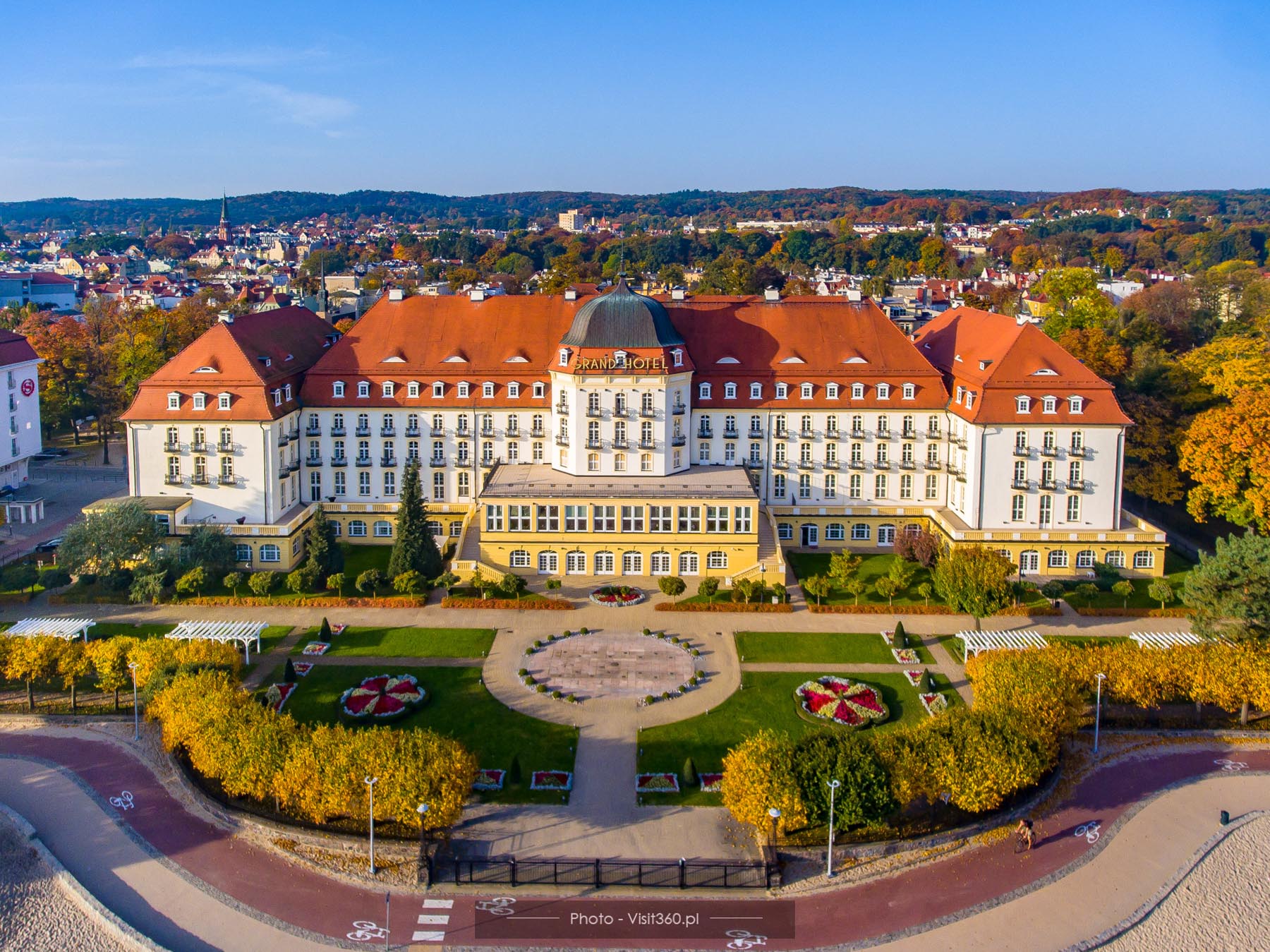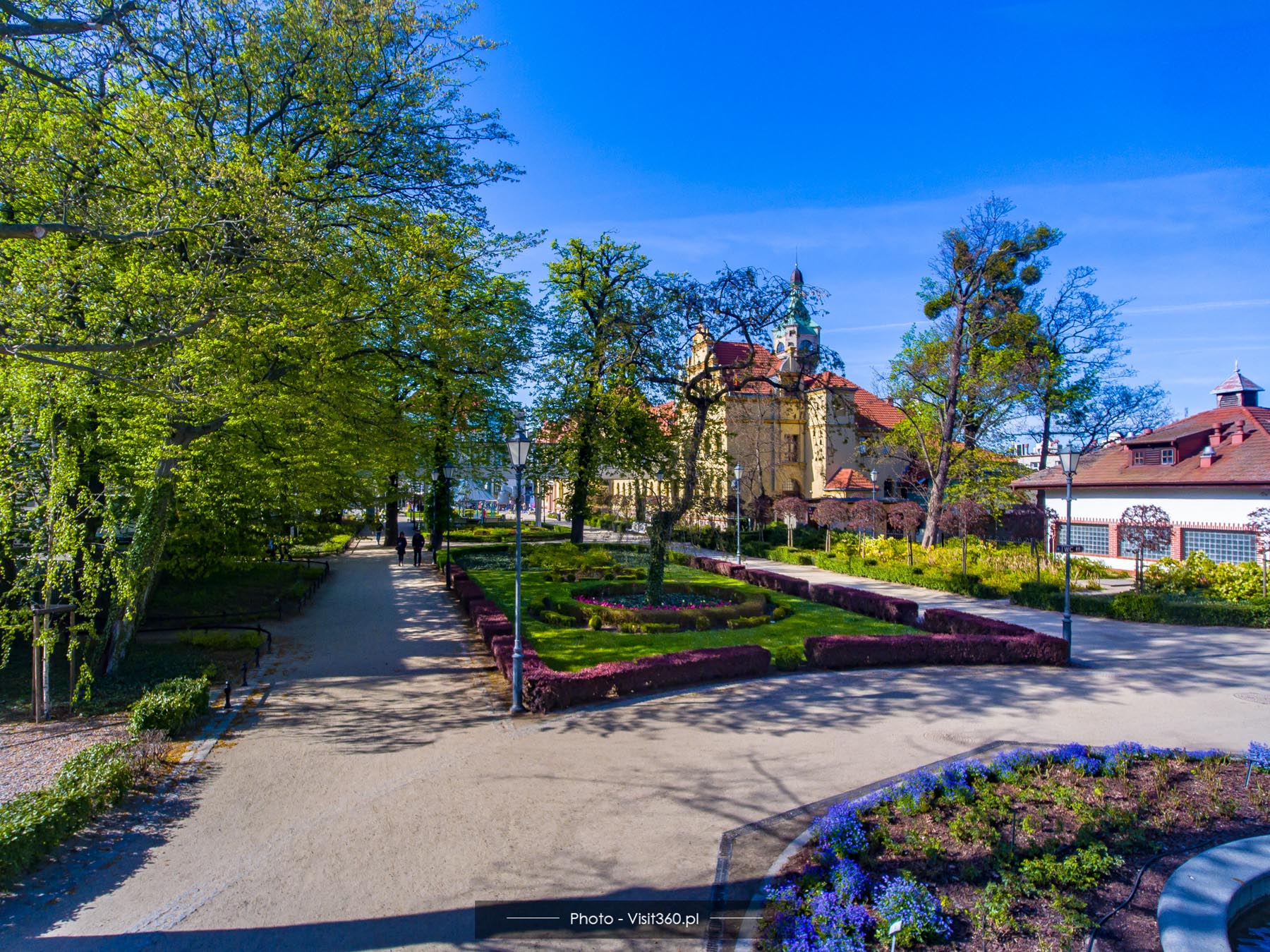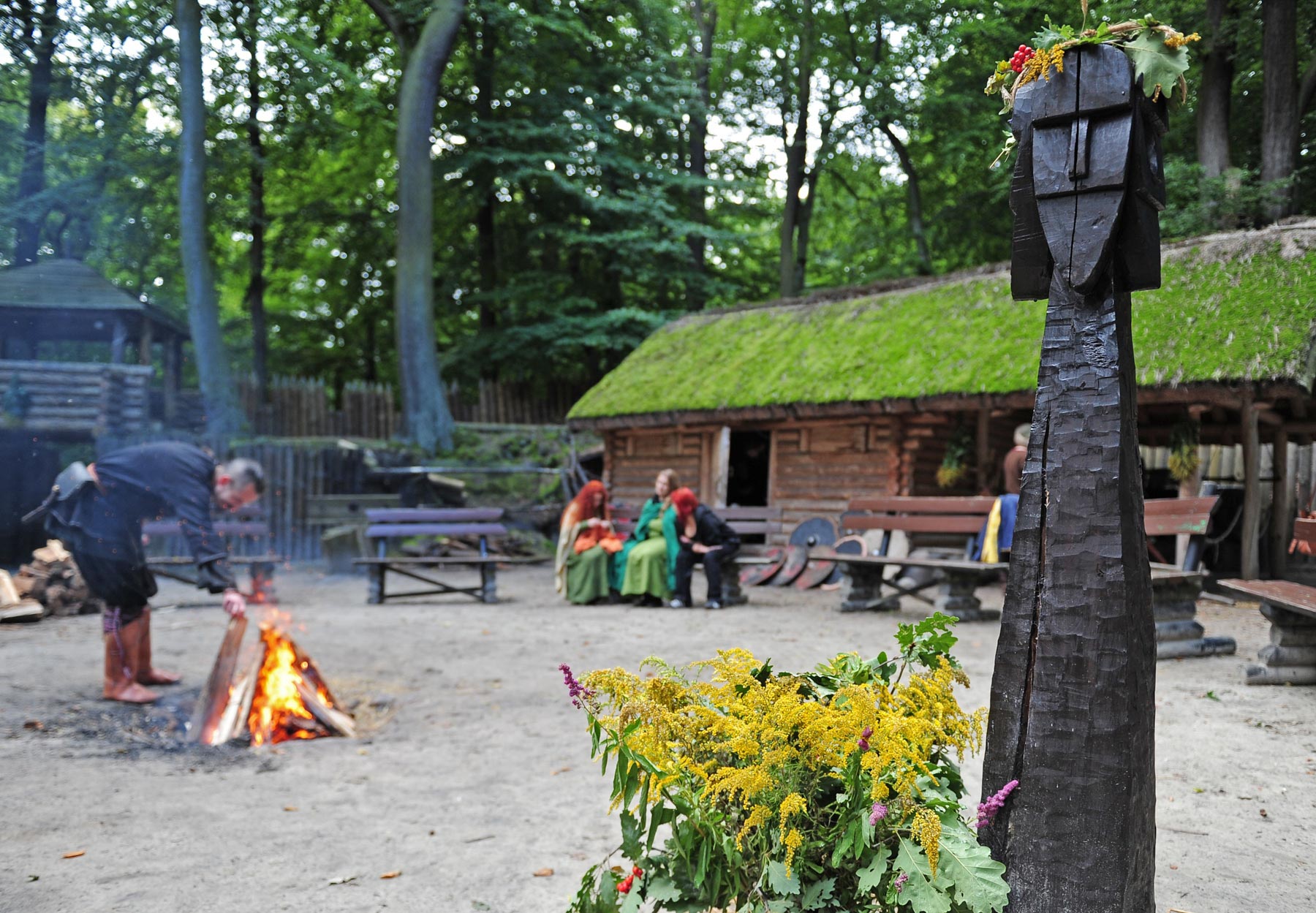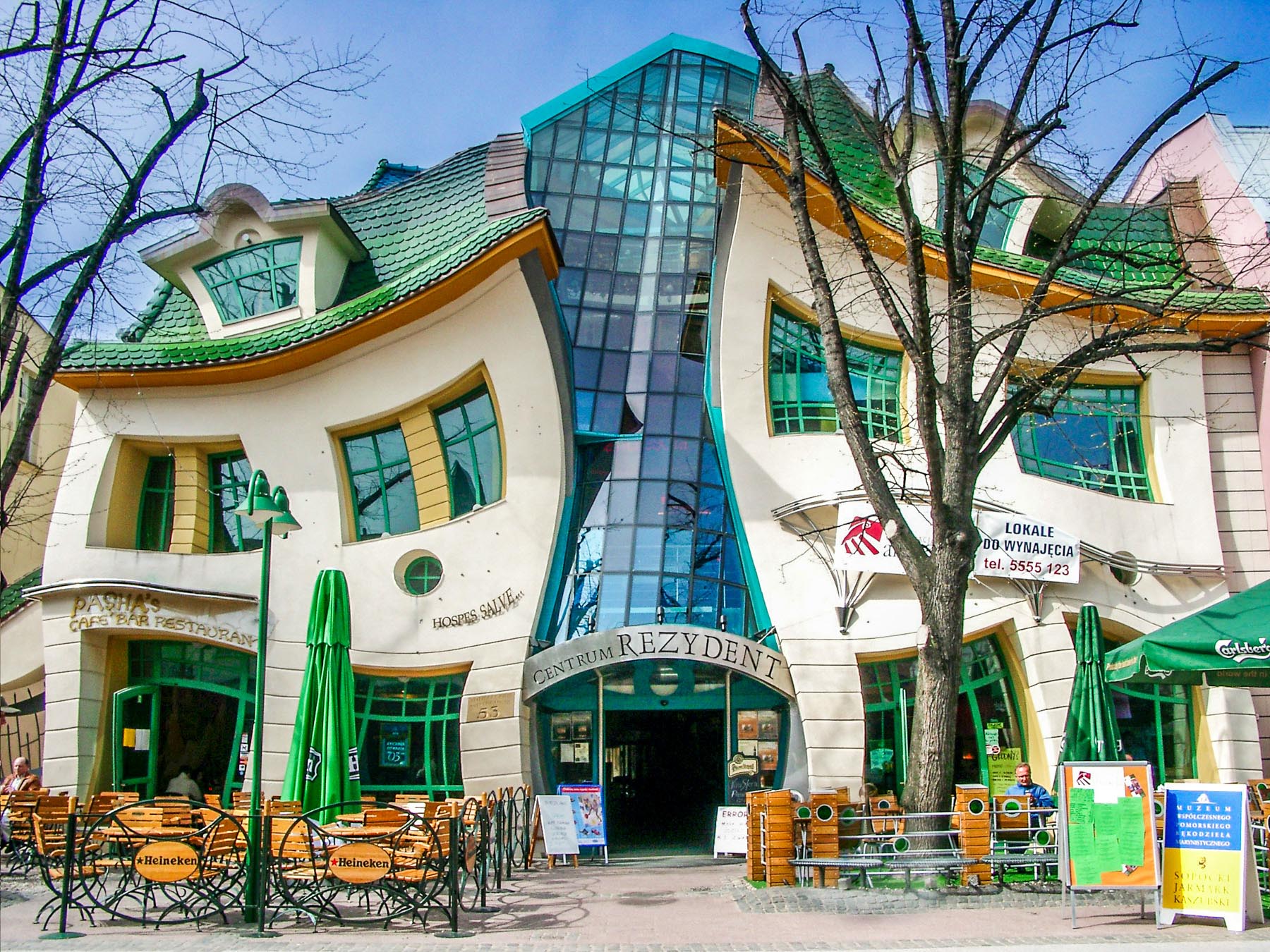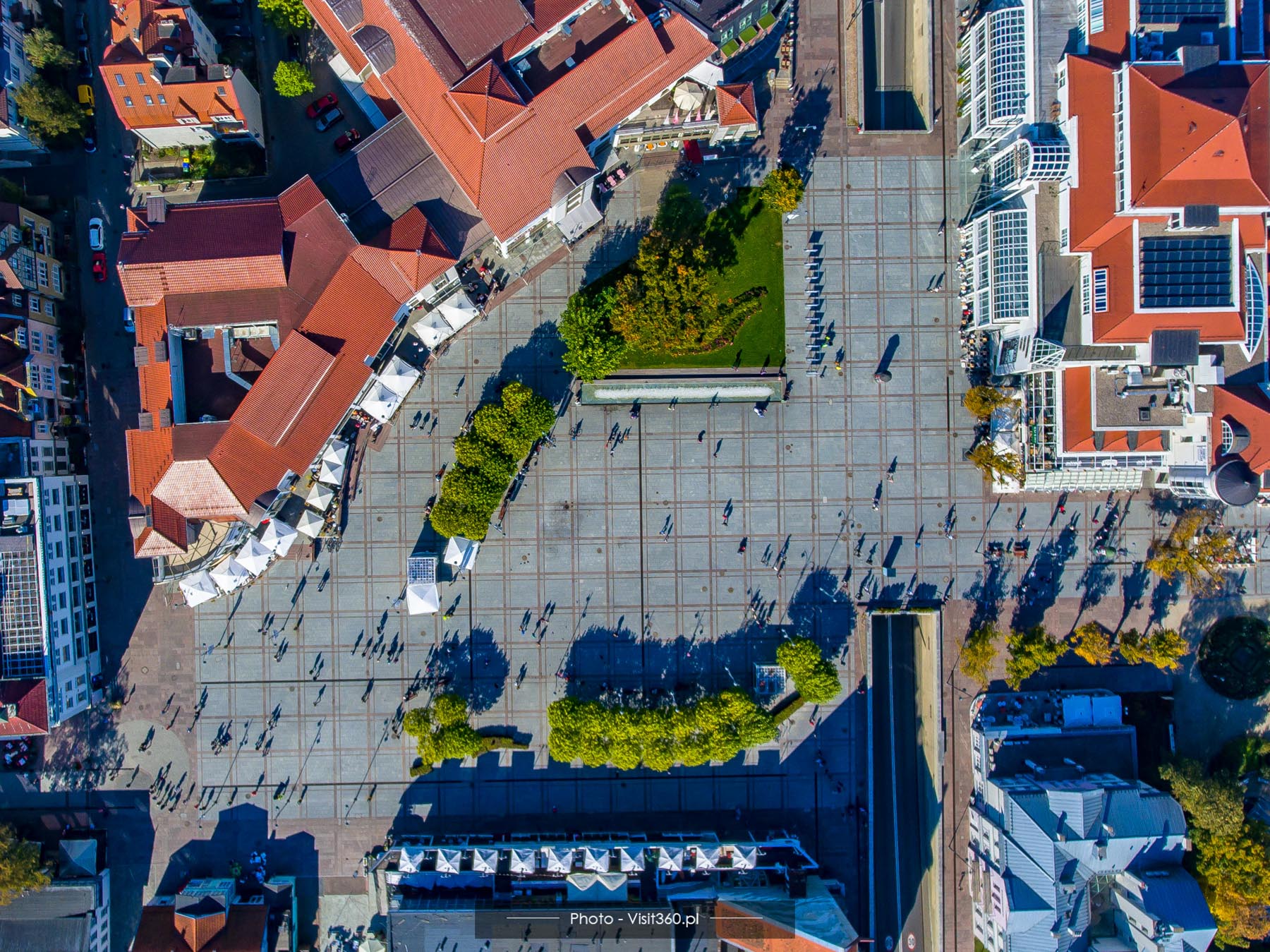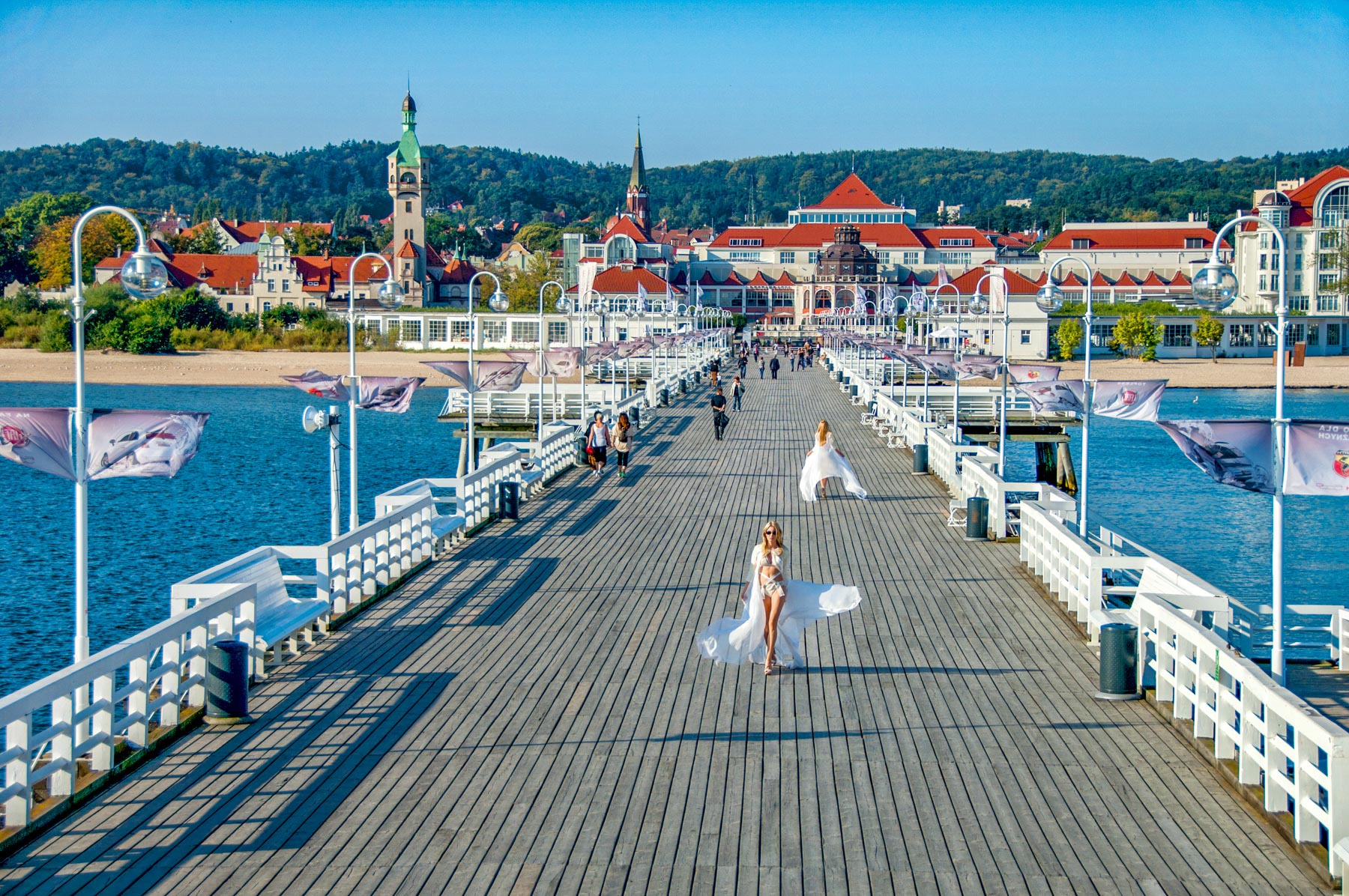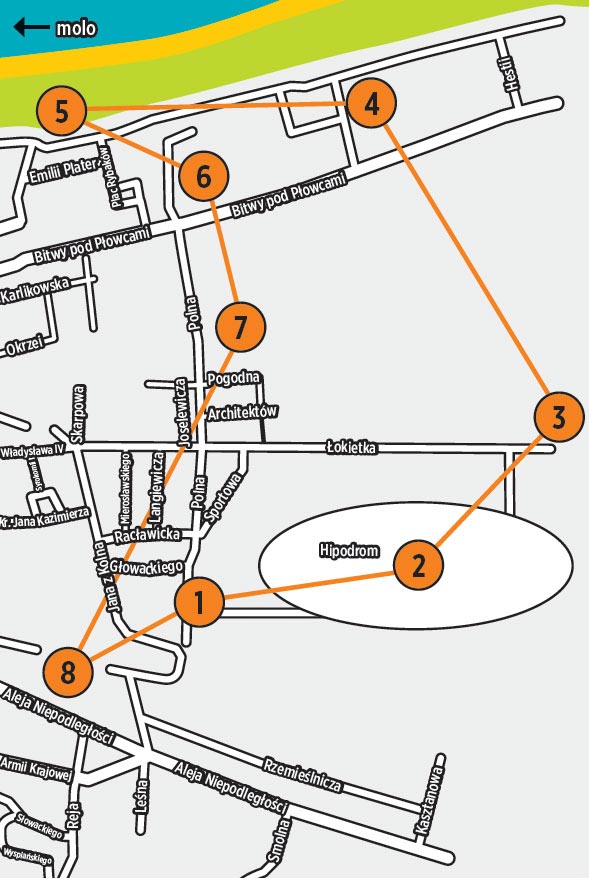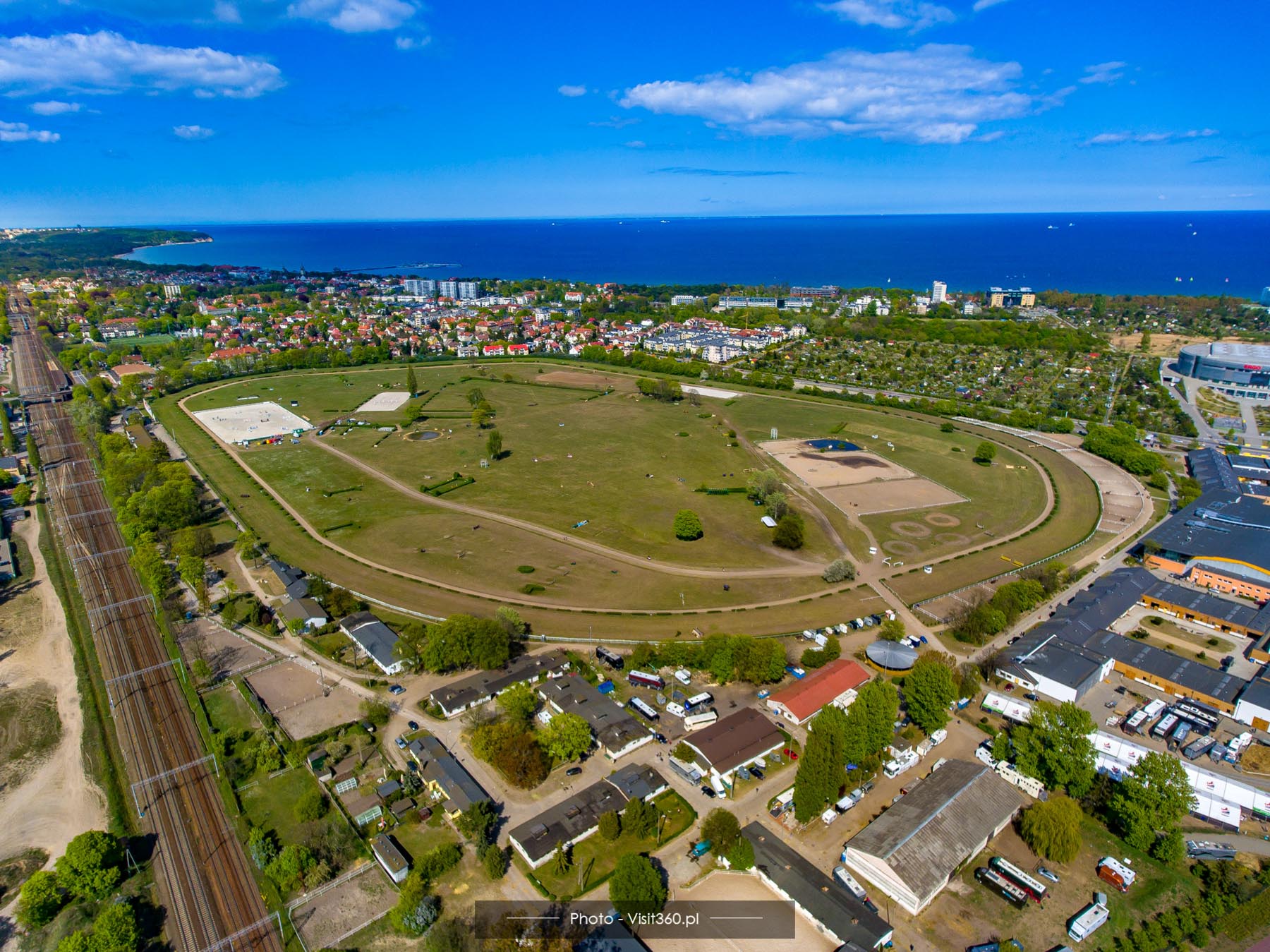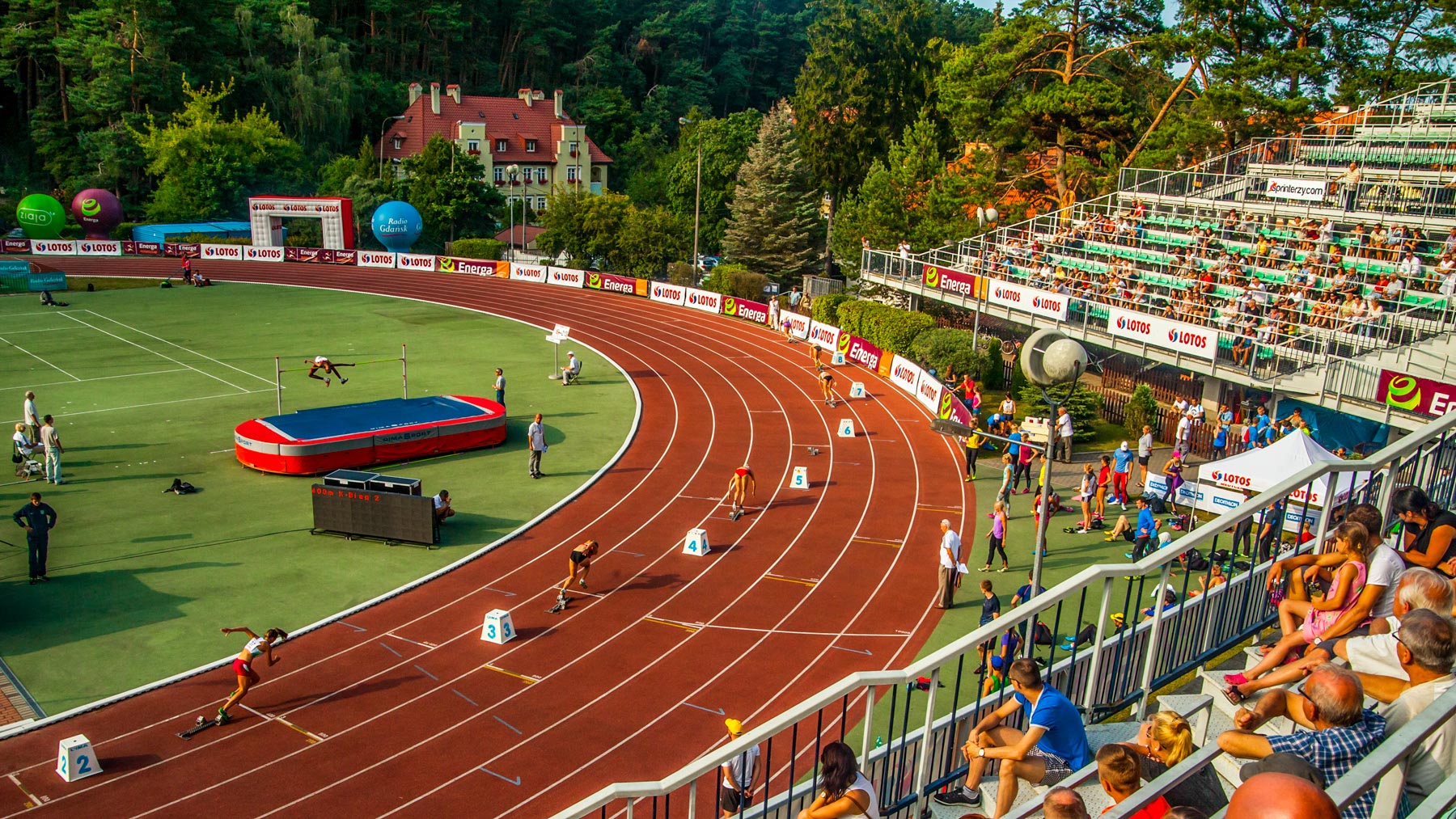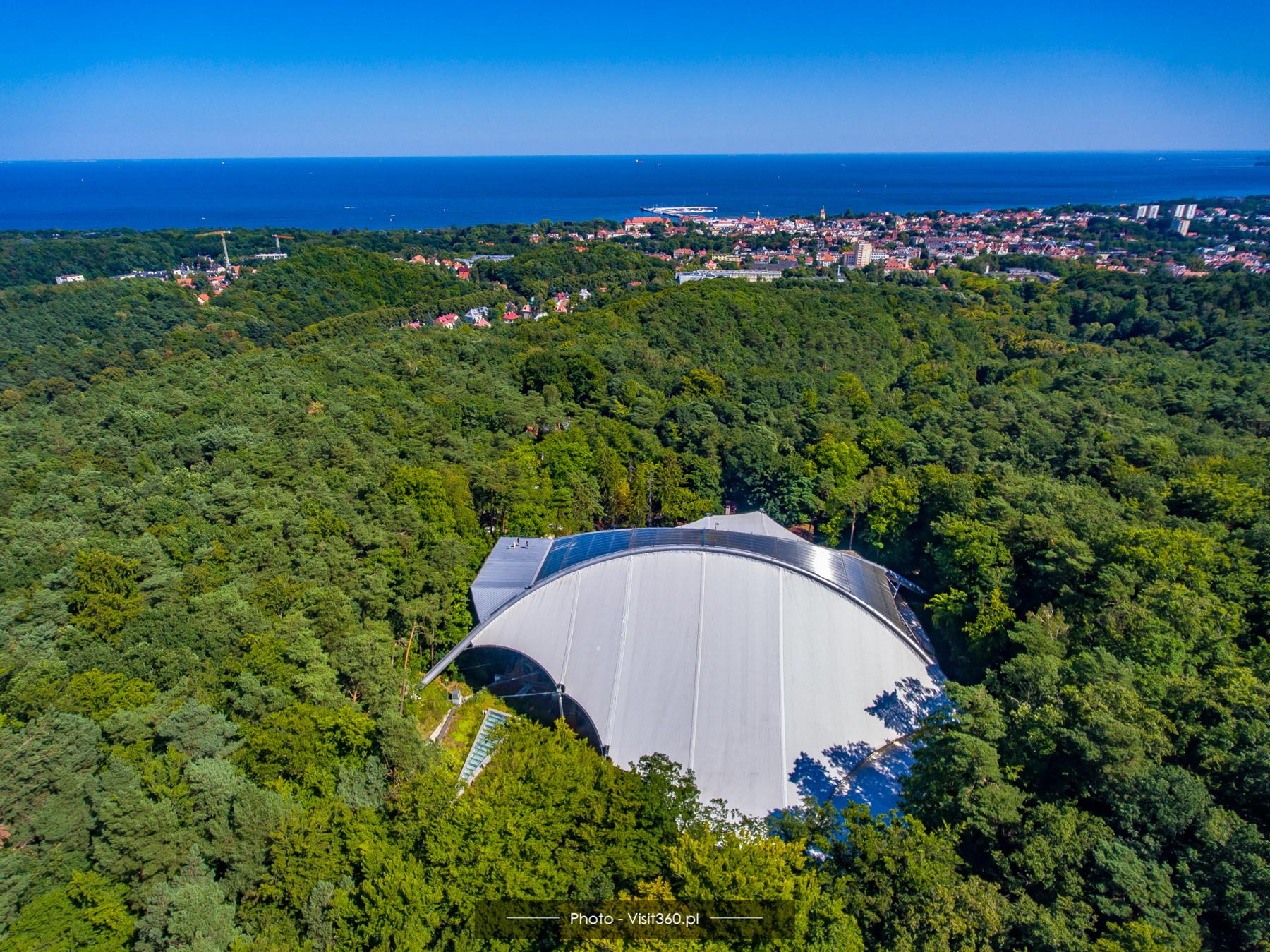WALKING ROUTES
WALKS IN GREEN SOPOT
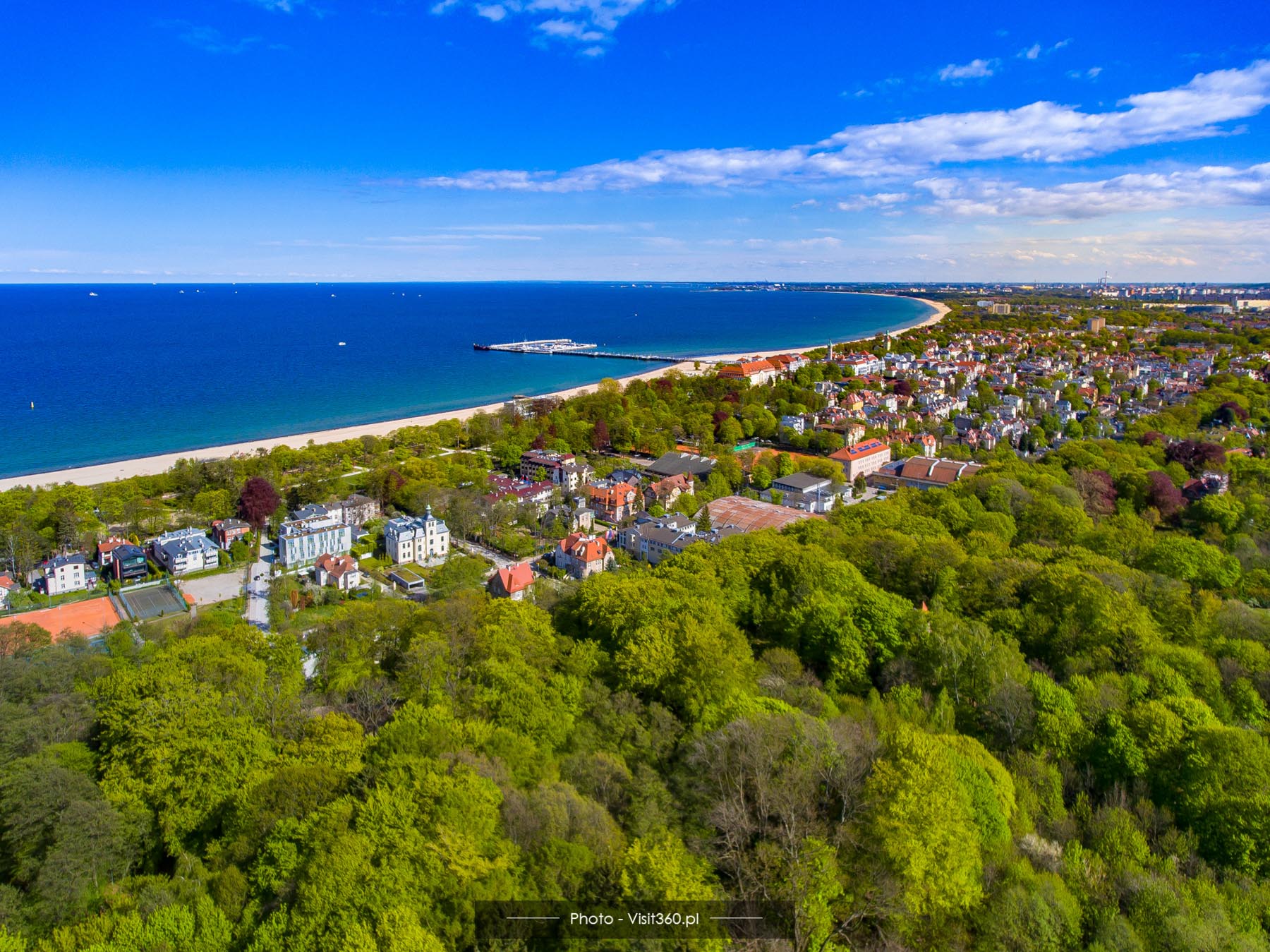
Sopot is not only beautiful sandy beaches but also a place ideally suited for walks and recreation. Over 60% of the city’s area is green.
It is worth going to the forests of the Tri-City Landscape Park, where picturesque walking routes are designated. The North and South Park, located along the beach, is a popular place to spend time actively, sheltering greenery from the sun and rest. Sopockie Błonia is a new green area with unlimited recreation possibilities.
For the lovers of active leisure, we have prepared a walking guide along 4 routes, covering all the most interesting places in Sopot, which can be reached on foot.
WALKING ROUTES
The Blue Trail – Northern Park Route
(czas pokonania trasy – około 2 godzin)
The North Park in Sopot stretches parallel to the sea shore with a 2 km long strip, from the Grand Hotel to the Swelina brook – the natural border with Gdynia.
In this seaside park, with an area of approx. 25 hectares, collision-free paths for pedestrians, cyclists and skaters have been created. An interactive educational path was also devoted to the flora, fauna and history of the park. Its characteristic elements are, among others: manicured alleys, a statue of Jan Jerzy Haffner, many sculptures, benches, playgrounds, and above all rich tree stands with common pines, black oaks, maples and beeches.
We start the route of the North Park under the Sofitel Grand Sopot (Grand Hotel) (1), which dazzles with its dignity. The hotel was built in 1927 and immediately became a synonym of class and luxury. The silhouette of the monumental building standing right next to the beach reflects the rich and anecdotal history of this one of the most excellent hotels in Poland. He hosted hundreds of the most prominent figures from the world of culture, politics and science. Among those whose visits are most often mentioned, there were Charles Aznavour, Marlene Dietrich, Charles de Gaulle, Greta Garbo and Jan Kiepura.
Currently, the hotel captivates with restored interiors, a unique atmosphere of a maritime resort and an unforgettable view of the sea.
Passing the Grand Hotel, we enter the North Park, where we can admire the impressive statue of Jan Jerzy Haffner – the founder of the spa in Sopot. Going deep into the park, we see an interesting building located on the edge of the beach. There are several institutions in it, including Theater on the Beach (2), which is an all-year impresario stage. In addition to excellent performances, every Sunday at At 11:00 there are performances for children.
Continuing the walk along the coastal alley, on the left we see one of the largest playgrounds for children, with slides, obstacle courses, swings, climbing ropes, a castle and a green belt, used for all forms of recreation. In this part of the North Park (3) extensive lawns with benches and wide paths favor walks. The largest lawn is the so-called Plac Mancowy, once serving fishermen for drying herring nets, so-called Mancy.
Going deep into the park, at the descent to the beach no. 15, we see another playground (4), directly on the beach.
Heading further north along the beautiful sandy beach, we reach the descent no. 10. Here, among the lush vegetation, there are collision-free routes for cyclists (5), walkers and skaters. 2,7 km of trails await those who love active leisure. The northern, “wild” part of the Sopot North Park, between Kamienna Potok and Swelina is a natural, wet forest. Overgrown eyelashes, giving this part of the park the appearance of the primeval forest, we find south of the mouth of Swelini. We can admire them from wooden jetties, which replaced regularly flooded,
asphalt path. Once this whole area was occupied by swamp alder forest. Currently, these trees have survived only in a few places, because the majority of the park has been drained using a network of drainage ditches. The lush, diverse forest built by beeches, common maples, sycamores, silver birches, sessile and sessile oaks, elms and stalks, small-leaved and broad-leaved limes, black alders, white and black poplars and common pines grows on overdried lands.
The Swelina stream (6) is the natural border between Sopot and Gdynia, and from here we set off on the way back through Kamienny Potok and Park Grodowy towards the center.
Walking along the avenue of Franciszek Mamuszki towards the Sopot pier, at the height of the entrance to the beach No. 5, we find a fork in the paths where a chapel with the image of the Sorrowful Christ stands (7). The chapel commemorates Father Tadeusz Cabała, parish priest of Saint. Andrzej Bobola in Sopot and architect Bruno Wandtke from Sopot. Next to it, turn right, in the direction opposite to the sea. We reach the stairs that lead in the most valuable part of the North Park – the Sopot scarp. The forest stand on the slope is a fertile lowland beech forest, in the undergrowth there is partially protected woodruff. The largest yew population of over 30 individuals was found here in the Tricity.
Overcoming the stairs, we reach a place loved by families, or the Sopot Aquapark (8). Water attractions have been planned for guests of all ages. It is an ideal place to spend time for children and adults. In the Aquapark there are: recreational pools, whirlpools, hydromassages, wild river, slides and a pool with a water slide and water toys for children.
Right next to it there is a bowling alley (9), where guests have at their disposal 6 tracks and a bar with snacks and drinks. After visiting the Aquapark, we continue our journey towards the center. From Zamkowa Góra Street through Sępia Street, we reach Haffner Street, where Grodowy Park is located. A densely forested gorge to the north of Sopot’s Grodzisko is probably the most valuable piece of Sopot nature. This wild corner has remained almost unchanged form until today. The City Council of Sopot in 2004 covered it with legal protection, as an ecological use under the name Wąwozy Grodowe. The area is heavily bogged down, hundreds of cold and clean springs pour here, creating swift brook. The area is covered by a natural forest, mainly with black alder. A wooden staircase ends with an observation point leading to the Gąski Gorge.
Going further, along Haffnera Street, we reach the Archaeological Park Grodzisko (10). This is the oldest monument in Sopot. The remains of the former castle are located in a picturesque scenery amidst lush greenery. The Museum’s offer is prepared for children, teenagers and adults alike. During many events in Grodzisk, attractions include archery, workshops of medieval crafts and reconstructions of battles.
Wandering further along Haffnera Street, we pass by consecutively sports facilities. Among them: an indoor swimming pool, Hala Stulecia Sopot and tennis courts. The Centennial Hall was put into use in 2001 on the occasion of 100 years of granting municipal rights to Sopot. Main matches of local sports teams and school competitions are played here. Tennis courts (11), however, are a unique place for the 120-year history of Sopot tennis. Turning left into Goyka street, we come to Powstańców Warszawy street, which we reach to the starting point of our trip – Grand Hotel.
Red Trail – A walking tour through the city centre
(estimated walking time – about 1.5 hours)
The Red trail passes through the city centre towards the pier and the sea, and then to the Main Railway Station through Southern Park and the Eliza stream. As well as the beauty of the surrounding nature, there are many attractions on the way, mainly for families with children.
We start the trip on what is known locally as ‘Little Monciak’, the upper part of the main promenade Bohaterow Monte Cassino, which you will find located between the railway tracks and Aleja Niepodległości. This part is much less frequented by tourists, but it is well worth visiting. Beautiful old trees grow here, where you can relax on unusual golden benches. There are also charming tenement buildings with restaurants and shops.
To the rear of one of these tenement buildings is the Escape Room (1). It is a place that provides entertainment for everyone and is a great place to spend time with friends or family. What is the game about? You have 60 minutes to get out of a locked room using the cleverly hidden clues.
Next, pass through the tunnel under the railway tracks where you will find yourself on the main part of Bohaterow Monte Cassino. The street is known throughout Poland by its shortened name – Monciak. On either side are picturesque tenement buildings, boutiques, pubs, cafes and restaurants. This is one of the most recognised places in Sopot, the heart of the city and the main meeting point for fun and relaxation.
Turn next into the first street on the left – Obrońców Westerplatte (Defenders of Westerplatte street). A cobbled road, surrounded by beautiful tenement buildings, which leads to a narrow footbridge. Next to the bridge, on the right, is a building of the City Public Library (2), in which Miniteka is situated. This is a place which was created for the youngest of booklovers. In addition to literature, there are also board games, computer games, audiobooks and an Xbox console. Miniteka also hosts creative workshops on various topics, book readings, performances of fairy tales, theatre and many special and educational events.
Turn right at the library and head onto Czyżewskiego street. This will lead you on a gently winding road back towards Monciak. Before you reach Monciak though you’ll pass, on your left, a children’s playground next to which is a beautiful historic building.
This is Dworek Sierakowskich (3), which is one of the oldest buildings in Sopot. Its history dates back to the 18th century when it was the home of a Polish nobleman. These days the Dworek, or Manor House, hosts concerts, poetry evenings, performances, film nights and meetings with writers and artists. It is also home to a small café and bar.
As you continue onwards back towards Monciak you will find a small, sweet manufacturers, where all sorts of sweets and lollipops are made by hand. If you want to, you too can take part in the production process and make sweets.
As you step back onto Monciak turn left and head downhill towards the sea. Your next point of interest is just past the intersection of Bohaterów Monte Cassino Street and Haffnera Street on the left.
Here, take a moment to admire a unique building, and one which is featured in almost every guide about Sopot. This is the Crooked House (4) (Krzywy Domek), which was built in 2003 and has become one of the best-known symbols of the city. Established in 2003, the building references the fairytale drawings of Sopot residents Jan Marcin Szancer and Per Dahlberg. It is one of the most photographed objects in Poland.
From there continue walking down Monciak. As you reach the end of the street you’ll see the famous SPATiF club in the upstairs of the last building on your right. This has been the favourite meeting place for Polish artists since it opened in the post-war years. The name is made from the initials of the organisation that created it – Stowarzyszenia Polskich Artystów Teatru i Filmu (SPATiF) or Association of Polish Theatre and Film Artists.
Behind the club is a square with a fountain of Jasia Rybak (5) or John the Fisherman – a young man with a basket full of fish on his head. The square is ringed by quaint fishermen’s houses which now host cafes and restaurants.
From Monciak, you walk out onto the wide expanse of the Plac Przyjaciół Sopotu (6) (Friends of Sopot Square), the largest square in Sopot. The square plays hosts to numerous events throughoutt the year such as the annual Sopot Literary Festival, which presents the culture and literature of a featured country each year. Plac Przyjaciół Sopotu is a unique place and acts as a kind of connection between the paths of tourists and residents.
The square is adorned by trees, benches and a fountain and dominated by the Haffner Center, where, as well as cafes, restaurants and clubs, there is also a cinema and wax museum. In the museum of wax figures in Sopot, you’ll see figures of such famous people as Angelina Jolie, Brad Pitt, Bill Gates, Tom Hanks and Cristiano Ronaldo.
The other impressive building at Plac Przyjaciół Sopotu, is the Dom Kuracyjny or Spa House (7). This is home to the State Art Gallery (8), the Salt Water Pump House, the Tourist Information Office and restaurants and cafes. The art gallery covers over one thousand square meters and is considered one of the best exhibition venues in Poland. Among others, paintings by Jacek Malczewski from the collection of the Lviv National Gallery, works by Georges Braque and works by Ivan Aivazovsky have been displayed here.
As you pass the Spa House on your left you are met by the iconic ‘MOLO’ sign, which signifies the entrance to the famous pier and gardens. To its right is a historic building, decorated with sculptures and erected in 1903 – the Balneological Department. Treatments continue here to this day and among others you will find procedures for the rehabilitation of motor organs, natural spa water baths, cryotherapy, hydrotherapy or inhalation. In front of the main entrance, among the rose flower beds, there is a stylish fountain from which Sopot natural spring water flows direct from the spring under the city.
On the north-eastern side of the building, there is a 30-metre tower, which now acts a viewing point, as well as the chimney of the hospital’s boiler room. In the years 1975-1999, the tower served as a lighthouse (9) and is still referred to as the lighthouse today.
Entering the pier gardens you reach what is called Skwer Kuracyjny or Spa Square (10). This is a very iconic part of the city covering an area of about 20,000 m2 and featuring a beautiful antique fountain, a concert stage, food outlets and beautifully kept gardens. A beautifully restored rotunda overlooks the square from the Spa House. In winter, you’ll find an artificial ice rink here, the only one in Poland with a view of the sea. Sport, music and special events also take place here.
One of the most eye-catching parts of the gardens are the carefully groomed Dutch lindens. Every year, their branches are pruned, so that the trees grow upwards and arch outwards to resemble candlesticks. These lindens have been growing and shaped here for nearly a hundred years.
The next point on our trail is the one that has been making Sopot famous since the beginning of the spa. This is the Sopot pier (11). The longest wooden pier in Europe, with a length of 511.5 m, the pier is the calling card of the city.
The pier began as a jetty for boats to dock. In time it became a recreational facility and a place where events were organised. During the summer holidays, there is a summer cinema on the pier, where deckchairs replace traditional cinema seats. Also in the summer boats moor at the end of the pier offering cruises to Gdansk, Hel or around the bay. Since 2011, a modern marina has offered mooring for more than 100 vessels. The marina (12) offers sailing courses for children. Of particular note for you as you walk the pier is the fact that at its end, the iodine concentration is twice as high as on land. This is proven to offer health benefits and many visit Sopot to enjoy the iodine-rich air.
As you leave the pier head back towards the lighthouse and leave the gardens by the other exit which takes you along the sea promenade and into the Southern Park.
This is the oldest park in the city, and its covers 3 hectares. It was created in 1823 by Jan Jerzy Haffner, the man recognized as the founder of modern Sopot. In the Southern Park, keep an eye for the impressive Evangelical Augsburg Church of the Saviour on the Skwer Otto Bowiena (Otto Bowien square) named after a pastor of the interwar period. In the park you will also see another of the stylish inhalation ‘mushrooms’ from which flows more of Sopot’s natural spring water. Finally you see what were originally built as the Łazienki Południowe or Southern Bathing Rooms (13), built on the edge of the park in 1907. These days the old changing rooms have been adapted to a Chinese-style hotel and restaurant.
As you continue along the seaside promenade with the beach to your left, you’ll come to the intersection with Chrobrego Street, found opposite beach entrance #26. Walk all the way up Chrobrego street, crossing ul. Grunwaldzka as you do. You’ll be passing through peaceful streets with some great examples of the architectural style Sopot is famous for.
As you reach the end and the intersection with Sobieskiego Street you’ll see an escarpment in front of you that stretches almost entirely through Sopot from its northern to southern borders. The escarpment is densely covered with beech, oak, elm and hornbeam trees and is a picturesque green corridor running through the city. Of particular value here are the huge veteran oaks which, thanks to their girth of at least 3m, are officially classified as ‘Monumental Trees’. The crowns of the trees create a dense canopy which shades the earth below from the sun and creates a truly magical atmosphere.
Cross over Sobieskiego street and walk apart the steps and follow the path that follows a bustling stream. This stream is called the Eliza stream (14) and it flows down the escarpment and onto the sea. The exact source of the stream is unknown, but it is believed to flow from three ponds located in the upper part of Sopot. For the most part the stream runs underground but the area here was revitalized in 2011 and its surroundings have been adapted for walking and recreational functions. At the Eliza creek, there is a plaque with a legend about dwarfs, called Sopot Ludki or the Sopot Folk.
Follow the path upstream where you’ll find yourself in the 2.6 hectare, Herbst Park. On either side of the park you will see interesting buildings. On the right is the city’s town hall, which has served as the seat of the Sopot Council since 1958.
On the left you will see Willa Herbstów, the former residence of a German manufacturer from Łódź.
Turn right out of the park, passing in front of the town hall and you’ll find yourself in a small cobbled square which a large monument of an EAGLE?? This monument commemorates all of the inhabitants of Sopot who were killed during WWII and the square itself, in which the monument stands, is named in honour or Father Władysław Szymański, a Polish priest who worked in the city before the war and who was arrested on the morning of September 1, 1939 and murdered by the Nazis at Stutthof camp in January 1940. A few feet further on, is a statue honouring the man considered to be Poland’s greatest composter, Fryderyk Chopin.
On the other side of the street, the modern building of the main train station emerges. The Sopot station (15) is not just a ticket office and waiting room. Inside the Sopot Centrum are shops, service points, pubs, restaurants, cafes, bakeries and a gym. There is also a modern multimedia library, called Sopotek. This combines a classic library with professional equipment, which can also be used by children. There is a variety of literature, magazines, board games, a play corner, computers and game consoles at their disposal. Meetings with artists, workshops, reading books and exhibitions are also held here.
SZLAK POMARAŃCZOWY – TRASA SPORTOWA
(czas pokonania trasy – około 2 godzin)
The orange route leads through the south-eastern part of Sopot, or Karlikowo. This district is located in the coastal belt and extends to the border with Gdańsk. The most characteristic points in this region are: a fishing harbor, rest houses, sanatoria, campsites, common areas and sports facilities, including ERGO ARENA, Sopocki Klub Żeglarski and Hippodrome. The route starts and ends at the stop of Szybka Kolej Miejska (SKM) Sopot Wyścigi (1).
Starting the journey from the Sopot Wyścigi station, we head towards Polna street, towards the historic hippodrome (2). This area is located in the vicinity of moraine hills and the Gulf of Gdansk. This is the place of international equestrian competitions, organized since the nineteenth century. Passing through the gate of the object, we pass the historic grandstand and cash register. The main path leads us to modern stables and halls. There are riding schools in them, which offer horse riding lessons for beginners and more advanced riders. This place combines learning and fun. You can learn a beautiful sport here, as well as learn the secrets of caring for horses. It is a great place for both children and adults.
Leaving the area of the Hippodrome, we can see a hall with a modern construction. ERGO ARENA (3) is another obligatory point on the sports route. The hall is one of the largest and most modern in Poland, it can accommodate 15 thousand. viewers. Various kinds of sports games, fairs, conferences and concerts are organized here. High standards of technological solutions make it possible to organize events at a global level at ERGO ARENA. In front of the hall there is a skatepark and a basketball court.
In July and August at ERGO ARENA, there is a free, 24/7 Eko parking lot for over 700 cars. The center of Sopot and the beach can be reached by melexes, which run every day from 10.00 to 20.00, every 20 minutes.
The next place on our trail is the Sopot Sailing and Rescue Center (4). To reach it, we have to go through the tunnel that runs from the left side of ERGO ARENA. A winding path among wild green leads towards the sea. It is the only place in Sopot where reedling has settled (a bird resembling a sparrow). Other species occurring in this area are: gray nightingale, cattle or stranger, which male has attractive, purple coloration. Going further, we pass the Hestia Park. There are small water mirrors, various types of trees and shrubs, alleys and glories in the form of a small, open pavilion with columns. After a few-minute walk down the route, walking along Hestia Street, we reach the beach. Sailing clubs are located here.
Windsurfing enthusiasts and catamarans will be especially pleased, because the Sopot Sailing and Rescue Center is considered one of the most modern and largest centers of this type in Poland and in the world. It is in Sopot that there are windsurfing and catamaran competitions on the rank of the European and world championships.
Strolling along the beach towards the pier, we encounter moored cutters on the road, with a fishing harbor (5). Here we can buy fresh and smoked fish from the Baltic Sea. It is also worth visiting the nearby Rybaki Square, which impresses with its original architecture. Once it was a fishing district, the old anchor in the middle of the square reminds us. The estate was designed in 1914 by Paul Puchmüller, a Sopot architect, the creator of the characteristic buildings of the resort.
Between the fishing harbor and the confluence of Polna and Bitwy pod Płowcami streets there is a small Karlikowski forest. It is a remnant of the former complex of natural coastal pine forest.
A fragment of this greenery is grown mainly by old pine, twisted from the sea winds. Noteworthy are also thickets of a closely protected shrub – sea buckthorn, naturally growing over coastal dunes and cliffs. In the part of the forest there is a rope park (6), divided into two parts, for older and younger children. The park is open from May to September.
Continuing the walk up Polna street, on the left we will see a huge green area. This area is Sopot’s Błonia (7), or several hectares of recreational areas that win the hearts of children and adults. There are playgrounds with swings, merry-go-rounds, sandpits, climbing rocks, etc. On the grounds there is also a football glade, a barbecue area and a catwalk. Sopockie Błonia delight walkers at any time of the year. In the early spring, the area enchants its visitors thanks to thousands of white and purple crocuses decorating the mounds created between ERGO ARENA and ERGO Hestia headquarters. After dark it is worth taking a romantic walk with climate-lit alleys.
The perfect ending of the sports route will be a visit on the go-kart track. To reach it, we head up Polna Street, to the station where we started the trip. Coming to the SKM Sopot Wyścigi stop, we cross the viaduct on Jana z Kolna street. Now our path reflects slightly to the right, along the railway tracks. After a few minutes walk we reach the racetrack. KartCenter (8) in Sopot is one of the largest and most modern go-kart tracks in Poland. It provides great fun for anyone who wants to feel like an F1 driver for a moment. Karting teaches strategy, mastery and precision at the wheel.
After playing on the track, we return again to the SKM Sopot Wyścigi station, from which trains depart for Gdansk and Gdynia every few minutes.
SZLAK ZIELONY – TRASA GÓRSKA
(time of traveling the route – about 1.5 hours)
The route of the green route leads us mainly through the forest areas of the Tri-City Landscape Park. We will be helped by the signs of Sopot walking paths made by PTTK (Polish Tourist and Sightseeing Society). The route starts at the trolleybus loop at the intersection of Aleja Niepodległości and Mikołaja Reja Street. Her end was designated in the Paramedic Inka park at Armii Krajowej street. Interesting places on our way will be lookout points and sports facilities.
We start the walk in the Sopot-Wyścigi district, at the intersection of Reja street and Aleja Niepodległości. Passing a small playground on the left, we head up the Reja street, so that after about 200 meters, cross the street parallel to the main communication route – the Home Army.
Going further, on the left side we will see the retention pond (1), which was created by damming the Karlikowski Stream, flowing in an open riverbed through the entire Świemirowska Valley and below the pond hidden under the ground. The water reservoir with the island in the middle is surrounded by old black alders. After modernization, it has become a new recreational place for residents and tourists. In the southern part there are paths for walkers and lawns with flower beds.
We continue to wander along Reja Street. The road is more and more reminiscent of a forest trail, but the surface is still asphalt. We reach the allotment gardens, which we have on the left and turn right into the forest path. We are now heading the green PTTK walking trail. Markings are visible on trees in the form of white and green stripes. After covering about 400 meters, on the right you will pass the border of the Nature Reserve “Zajęcze Wzgórze”, which covers an area of 11.7 hectares. First of all, old beech and oak trees are protected there. There are also about 90 species of plants
vascular. Going left, we reach the hill which is called Gliniana Góra (2). From here, there is a view of the sea and the Sheep’s Valley, with the athletics stadium located there (3). The name comes from the former use of this area for grazing sheep from the Cistercian monastery farm.
We continue the walk along the green trail. Gorges lead us along the so-called Level Hills, to the hill called the Small Star. Not only walkers but also cycling enthusiasts meet here. The main walking routes and the Sopot walking routes cross here.
From the Little Star, we head towards the black walking trail, where after about 300 meters we reach Łysa Góra (4). The top of the hill is another great viewpoint from which we can observe both Sopot, the bay and Gdańsk. In winter, the Łysa Góra slope becomes a paradise for skiers and tobogganers. It has a lift and lighting, which allows you to drive until late evening hours. At the top there is a 286 meter lift. Łysa Góra
rises to 110 m on the city and is the only ski slope in Poland with a view of the sea.
Going further along the black tourist trail, on the left you can see the roof of the Forest Opera (5). This is one of the most outstanding facilities in Europe in terms of acoustics. Apart from exceptional concerts and cultural events, the Opera organizes events, workshops and shows for children. The Opera area is surrounded by forest, away from the hustle and bustle and urban noises. It is an ideal place to awaken the creative activity of children.
Going down the Forest Opera area along the black trail, we enter the Olympic Hill, where the soldiers of the Red Army are lying killed in the war in 1945. Then, go down the stairs to the Moniuszki street, where the Nowowiejski pond is located. This small pond is locally referred to as the Sea Eye (6). Residents like to rest here from the hustle and bustle of the city. This is due to the interesting composition of greenery and water. Trees of various species on the one hand constitute a natural barrier to the urban buzz, on the other hand, on a hot day they create a pleasant shade. Here we can find English oaks, common maples and maples.
Going to the other side of Moniuszki street, vis a vis the Morskie Oko, we have the entrance to the next forest lookout point – Wzornia Strzeleckie (7). From this place, we can see Sopot and the Gulf of Gdansk. The hill got its name because of the location. There was the headquarters of the shooting club, built at the beginning of the 20th century. There was a shooting range by the hill.
We end our hiking trail down Moniuszki street. We reach the roundabout to them. Czesław Niemen, located at the building of the Faculty of Management at the University of Gdańsk. We go to the other side of the street where the Paramedic Inka park is located (8). There are two monuments on this small piece of greenery. One is devoted to the fallen soldiers of the Home Army. The second commemorates Danuta Siedzikówna with the nickname “Inka”, who was a nurse and a liaison officer in the 5th Wilno Brigade of the Home Army.





